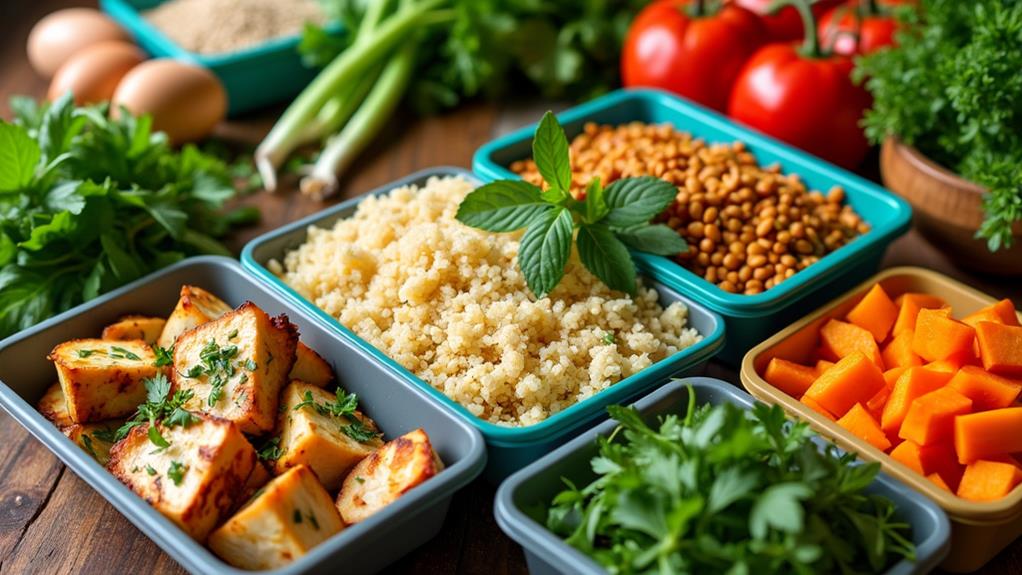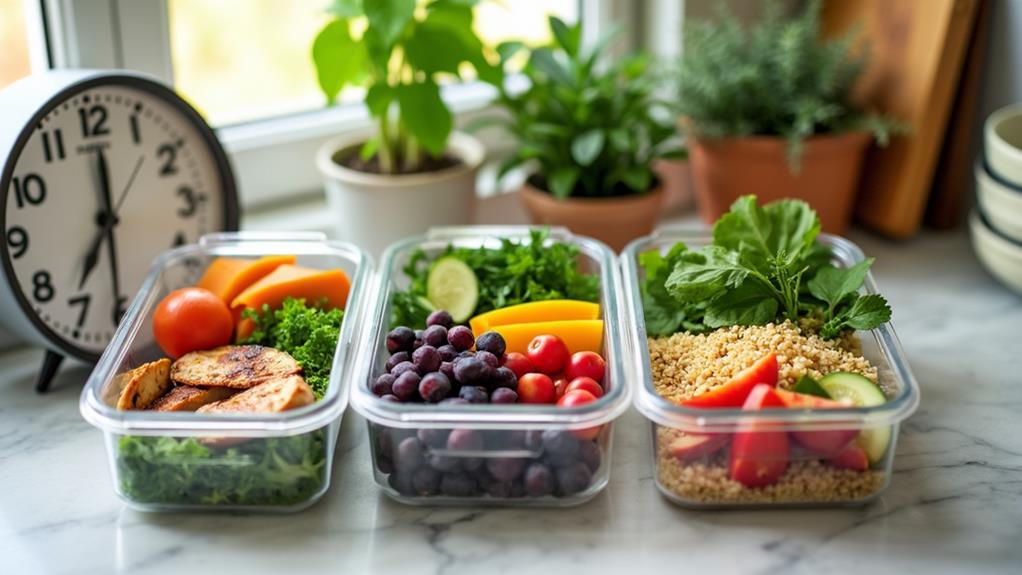Just as a well-composed symphony relies on the right balance of instruments, your meal prep needs ideal macronutrient ratios to create harmony in your diet. You might be wondering where to start or how to tailor these ratios to fit your unique lifestyle and goals. By understanding the basics of macronutrients and calculating your individual needs, you can make informed choices that enhance your meals. What follows are five practical tips that can transform your approach to meal prep and ultimately support your health and performance.
Understand Macronutrient Basics

To truly grasp meal prep, you need to understand macronutrient basics. Macronutrients—carbohydrates, proteins, and fats—each play distinct roles in your body. Carbohydrates are your primary energy source, fueling your workouts and daily activities. Proteins are vital for muscle repair and growth, while fats support hormone production and nutrient absorption. Knowing these macronutrient functions helps you make informed choices about your meals.
Nutrient timing also matters in meal prep. By strategically consuming macronutrients around your workouts, you can maximize your performance and recovery. For instance, having a balanced meal with carbs and protein before exercising provides energy, while post-workout meals rich in protein help repair muscle tissues.
When you plan your meals, consider how these macronutrient functions and timing can align with your fitness goals. Whether you aim to build muscle, lose weight, or maintain energy, understanding how to balance these nutrients will enhance your meal prep strategy.
Prioritize whole foods, and pay attention to how different combinations affect your energy and performance throughout the day. This knowledge will empower you to create meals that not only taste great but also support your overall well-being.
Calculate Your Individual Needs
Understanding macronutrient functions is just the beginning; the next step involves calculating your individual needs based on your specific goals and lifestyle.
To create a meal prep plan that works for you, consider these key factors:
- Activity Level: Are you sedentary, moderately active, or highly active? Your energy needs will vary accordingly.
- Goals: Are you looking to lose weight, gain muscle, or maintain your current physique? Each goal requires a different macronutrient distribution.
- Dietary Preferences: Do you follow a specific diet, like vegetarian or keto? Your food choices will influence your macronutrient ratios.
- Age and Gender: These factors can affect your metabolism and nutritional requirements.
- Health Conditions: Any existing health issues may require adjustments to your macronutrient intake.
Prioritize Protein Sources

When planning your meals, prioritizing protein sources is essential for achieving your health and fitness goals. Incorporating lean protein into your meal prep can help you build muscle, repair tissues, and maintain a healthy metabolism. Aim for protein-rich foods like chicken breast, turkey, fish, legumes, and low-fat dairy. These options provide the necessary amino acids without excess saturated fat.
Protein timing is also vital. Distributing your protein intake evenly throughout the day can enhance muscle protein synthesis. Try to include a source of lean protein in each meal and snack. This approach not only supports muscle recovery after workouts but also helps you feel full, reducing the temptation to snack on less nutritious options.
Don't overlook plant-based proteins if you're vegetarian or vegan. Quinoa, tofu, and chickpeas are excellent choices that can complement your dietary needs.
Balance Carbs and Fats
Finding the right balance between carbohydrates and fats is crucial for a well-rounded meal prep strategy. Both macronutrients serve important roles in your diet, providing energy and supporting bodily functions.
Understanding how to incorporate diverse carb sources and fat types can help you create balanced meals that keep you satisfied and energized.
Here are some tips to achieve that balance:
- Choose whole grain carbs: Opt for brown rice, quinoa, or whole wheat pasta over refined grains.
- Include healthy fats: Use sources like avocados, nuts, and olive oil to enhance flavor and nutrition.
- Monitor portion sizes: Verify that your meals include an appropriate ratio of carbs to fats—generally, aim for 45-65% of your daily calories from carbs and 20-35% from fats.
- Mix and match: Pair carb sources with different fat types, like combining sweet potatoes with almond butter for a delicious treat.
- Listen to your body: Pay attention to how different carb and fat combinations affect your energy levels and satiety.
Adjust for Meal Frequency

Adjusting your meal prep for frequency can greatly impact your energy levels and overall health. When you consider meal timing, it's important to align your macronutrient ratios with how often you eat.
If you prefer frequent meals, such as five to six smaller portions throughout the day, adjust your macronutrients to sustain energy. Focus on balanced carbs, proteins, and healthy fats in each meal to keep your blood sugar stable and avoid energy dips.
On the other hand, if you opt for fewer meals, like two to three larger ones, you may need to increase your portion sizes to meet your daily caloric needs. This might mean adjusting your macronutrient ratios to guarantee each meal is nutrient-dense enough to fuel your activities.
Consider your lifestyle and activity levels when determining meal frequency. If you're more active, eating more often may help maintain higher energy levels, while those with a sedentary lifestyle might find that fewer meals suffice.
Staying mindful of how meal timing affects your performance and well-being is vital for optimizing your nutrition strategy.
Conclusion
In the quest for perfect macronutrient ratios, it's ironic how often we overlook the basics. You can meticulously calculate your needs, stock up on lean proteins, and balance your carbs and fats, yet still feel lost in the kitchen. Remember, meal prep isn't just about numbers; it's about enjoying what you eat. So, embrace the process, listen to your body, and let your meals be as fulfilling as the meticulous planning behind them. Happy prepping!










